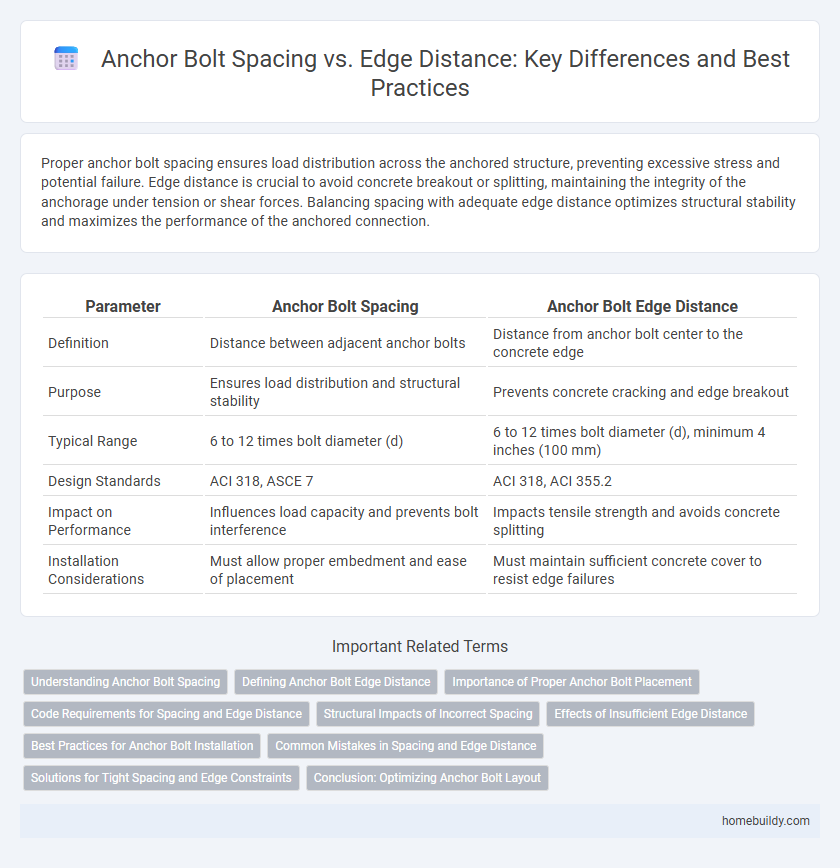Proper anchor bolt spacing ensures load distribution across the anchored structure, preventing excessive stress and potential failure. Edge distance is crucial to avoid concrete breakout or splitting, maintaining the integrity of the anchorage under tension or shear forces. Balancing spacing with adequate edge distance optimizes structural stability and maximizes the performance of the anchored connection.
Table of Comparison
| Parameter | Anchor Bolt Spacing | Anchor Bolt Edge Distance |
|---|---|---|
| Definition | Distance between adjacent anchor bolts | Distance from anchor bolt center to the concrete edge |
| Purpose | Ensures load distribution and structural stability | Prevents concrete cracking and edge breakout |
| Typical Range | 6 to 12 times bolt diameter (d) | 6 to 12 times bolt diameter (d), minimum 4 inches (100 mm) |
| Design Standards | ACI 318, ASCE 7 | ACI 318, ACI 355.2 |
| Impact on Performance | Influences load capacity and prevents bolt interference | Impacts tensile strength and avoids concrete splitting |
| Installation Considerations | Must allow proper embedment and ease of placement | Must maintain sufficient concrete cover to resist edge failures |
Understanding Anchor Bolt Spacing
Anchor bolt spacing refers to the distance between individual anchor bolts within a fastening system, which directly affects load distribution and structural integrity. Proper spacing ensures that bolts do not interfere with each other's load zones, minimizing stress concentrations and preventing material failure. Understanding the balance between anchor bolt spacing and edge distance is crucial for optimizing strength while avoiding edge tearing or concrete breakout.
Defining Anchor Bolt Edge Distance
Anchor bolt edge distance refers to the minimum distance between the center of an anchor bolt and the edge of the concrete or structural element, ensuring adequate concrete cover to prevent cracking and provide sufficient load transfer. Proper edge distance is critical for maintaining the structural integrity and avoiding spalling under tension or shear forces. Anchor bolt spacing, by contrast, focuses on the center-to-center distance between bolts, which must be optimized without compromising edge distance requirements to balance load distribution and prevent concrete failure.
Importance of Proper Anchor Bolt Placement
Proper anchor bolt spacing ensures even load distribution across the structure, preventing excessive stress that could lead to material failure. Maintaining adequate edge distance is crucial to avoid concrete breakout and ensure the anchor's full load capacity is utilized. Correct placement of anchor bolts enhances structural stability, safety, and longevity by minimizing the risk of cracks and ensuring optimal performance under dynamic loads.
Code Requirements for Spacing and Edge Distance
Anchor bolt spacing and edge distance are critical parameters defined in building codes such as ACI 318 and AISC standards to ensure structural integrity and load distribution. Minimum anchor bolt spacing typically depends on the bolt diameter, material strength, and concrete thickness, while edge distance requirements prevent concrete breakout and provide sufficient anchorage to resist tension and shear forces. Proper adherence to code-prescribed values, such as a minimum edge distance of 4 times the anchor diameter or as specified in design tables, ensures safety and durability in anchor bolt applications.
Structural Impacts of Incorrect Spacing
Incorrect anchor bolt spacing can compromise load distribution, leading to uneven stress concentrations and potential structural failure. Insufficient edge distance increases the risk of concrete breakout or splitting, reducing anchor capacity and overall stability. Maintaining proper spacing and edge distance is critical for ensuring structural integrity and preventing premature deterioration.
Effects of Insufficient Edge Distance
Insufficient edge distance in anchor bolt installation leads to concrete breakout, reducing load capacity and compromising structural stability. Closely spaced anchor bolts exacerbate stress concentration, increasing the risk of cracks and premature failure. Proper edge distance ensures optimal load distribution and enhances anchor bolt performance under tension and shear forces.
Best Practices for Anchor Bolt Installation
Optimal anchor bolt spacing ensures load distribution without causing concrete splitting, while proper edge distance prevents edge breakout and maintains structural integrity. Best practices recommend maintaining a minimum distance of at least 10 times the anchor diameter from edges and spacing anchor bolts at least 6 to 12 times the bolt diameter apart. Adhering to these guidelines improves anchorage performance, reduces stress concentrations, and enhances overall safety in structural installations.
Common Mistakes in Spacing and Edge Distance
Common mistakes in anchor bolt spacing and edge distance include placing bolts too close to each other, which compromises load distribution and structural integrity. Inadequate edge distance often leads to concrete splitting or cracking under load, reducing the anchor's effectiveness. Proper adherence to manufacturer guidelines and design codes like ACI 318 ensures optimal spacing and edge distances to prevent these failures.
Solutions for Tight Spacing and Edge Constraints
Optimizing anchor bolt spacing and edge distance requires precise calculations to ensure structural integrity while accommodating tight constraints. Solutions include using high-strength bolts, increasing the concrete's compressive strength, or incorporating reinforcing steel around bolts to reduce stress concentrations. Implementing specialized anchor designs such as undercut or chemical anchors also enhances performance in limited spacing and edge distance conditions.
Conclusion: Optimizing Anchor Bolt Layout
Optimizing anchor bolt layout requires balancing spacing and edge distance to ensure structural integrity and load distribution. Adequate spacing prevents bolt group interaction and improves shear capacity, while sufficient edge distance minimizes edge breakout and concrete splitting. Prioritizing both parameters within design standards maximizes anchor performance and durability.
anchor bolt spacing vs anchor bolt edge distance Infographic

 homebuildy.com
homebuildy.com